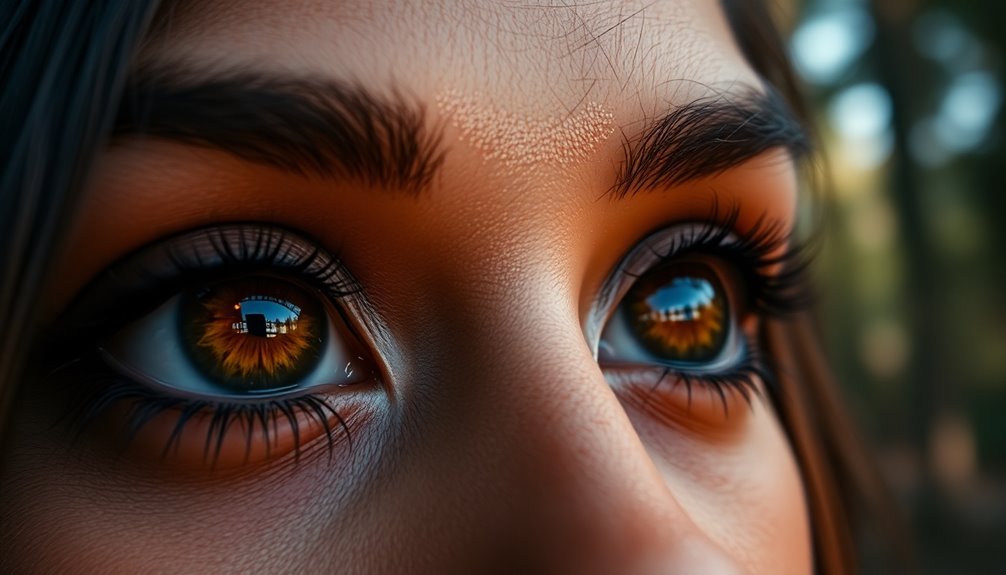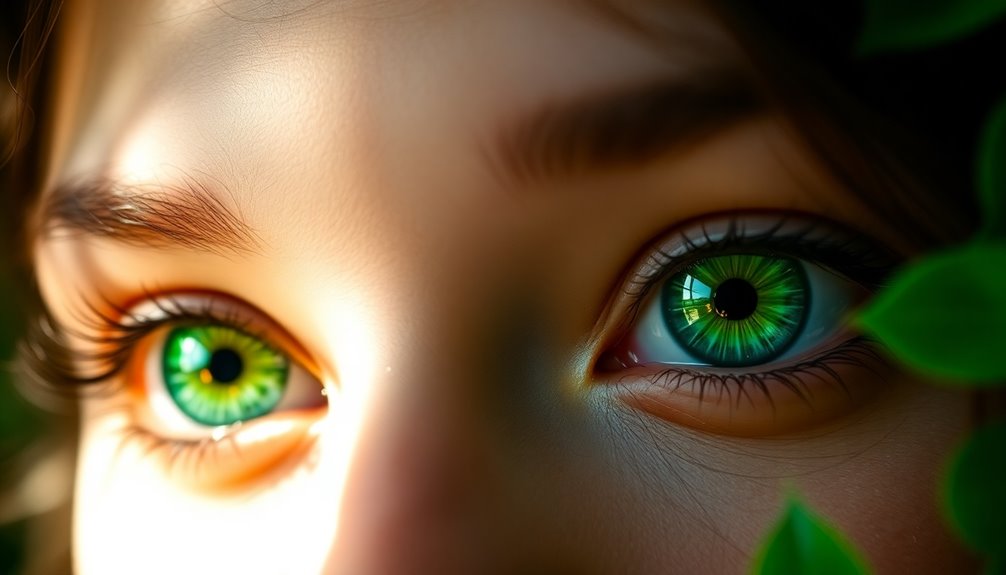In Edgar Allan Poe's "The Tell-Tale Heart," symbolism adds depth and excitement to the story! The old man's eye represents the narrator's fears and obsessions, leading him to madness. The heartbeat symbolizes overwhelming guilt, growing louder as his anxiety builds. Finally, the floorboards hide the old man's body, showing the struggle between sanity and chaos. Together, these symbols reveal the narrator's internal battles and the consequences of his actions. Each element is thrilling and intense, making the story unforgettable. If you're curious about how these symbols interact, there's so much more to discover!
Key Takeaways
- The old man's eye symbolizes the narrator's fear of judgment and represents his internal moral struggles and obsessions.
- The heartbeat serves as a powerful symbol of guilt, reflecting the narrator's emotional turmoil and escalating paranoia.
- Floorboards conceal the old man's body, representing hidden horror and the narrator's futile attempts to hide his guilt.
- The contrast between the eye's rationality and the heartbeat's guilt highlights themes of madness and moral decay within the narrator.
- The story illustrates the interplay between conscience and justice, emphasizing that truth ultimately emerges through overwhelming guilt.
Overview of Symbolism
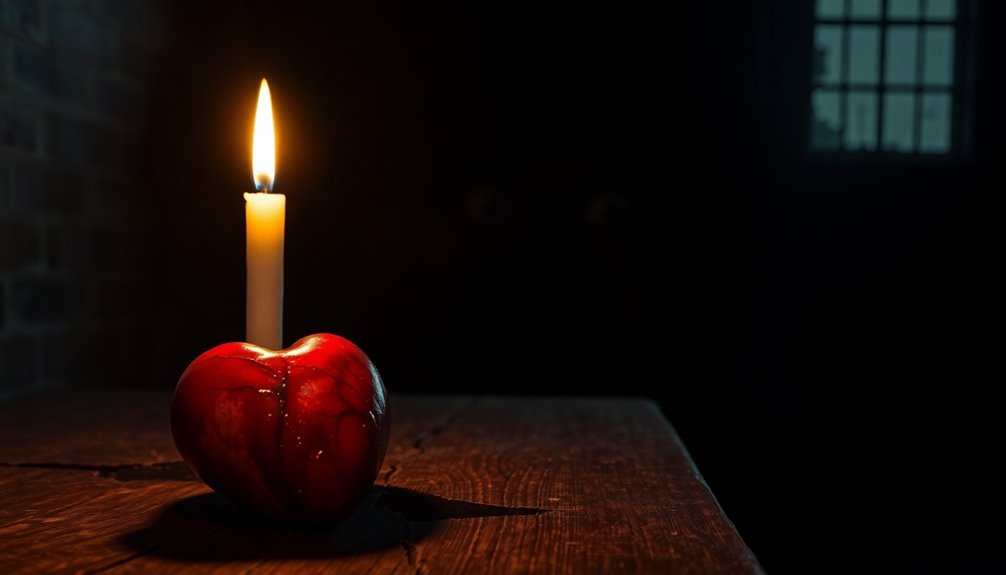
Symbolism plays an essential role in Edgar Allan Poe's "The Tell-Tale Heart," enriching the narrative and deepening its psychological impact. As you immerse yourself in the story, you'll notice how the old man's eye symbolizes the narrator's fear of judgment. This eye represents the darker parts of human nature and the narrator's own moral struggles. It's a creepy detail that adds to the tension.
On the other hand, the heartbeat serves as a powerful symbol of guilt. The narrator can't escape the sound of that heartbeat, which embodies his conscience. Despite all his efforts to hide his crime, this relentless sound drives him to confess. Isn't that fascinating?
Moreover, the floorboards symbolize the facade of sanity the narrator tries to maintain. Underneath, he hides the gruesome truth of his actions.
The contrast between the eye and the heartbeat really highlights the conflict between what we see and how we feel. While the eye represents rationality, the heartbeat reveals overwhelming guilt. Through vivid imagery, Poe connects readers to themes of guilt and madness, making the story even more compelling. Isn't it exciting to explore these symbols?
The Eye as a Symbol
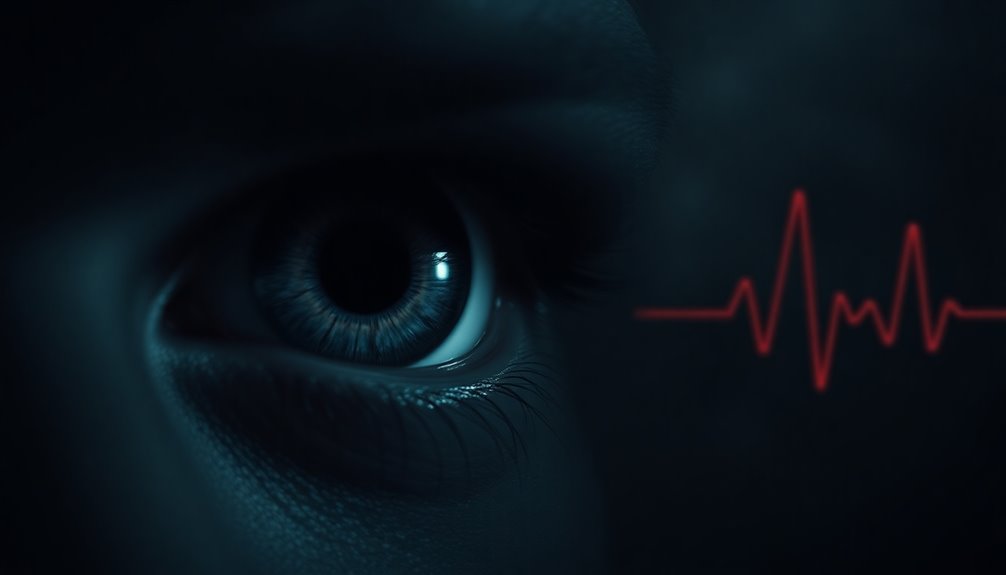
The old man's eye stands out as a potent symbol in "The Tell-Tale Heart," embodying the narrator's deepest fears and obsessions. You can see how the eye represents evil and malevolence, driving the narrator to madness. It's not just any eye; it resembles a vulture's eye, which makes you think about mortality and the fear of death. Additionally, the emotional turmoil associated with the narrator's actions may reflect the impact of parental infidelity, showcasing how unresolved fears can manifest in destructive behaviors.
Here's a quick look at how the old man's eye influences the narrator:
| Symbolic Aspect | Meaning |
|---|---|
| Eye and Evil | Represents the narrator's fear and obsession with malevolence. |
| Vulture's Eye | Symbolizes death and the narrator's anxiety about judgment. |
| Projection of Malice | Reflects the narrator's disturbed reality and his madness. |
| Eye and Identity | Highlights the narrator's internal conflict with his own self. |
| Trigger of Violence | The eye provokes violent impulses, leading to murder. |
As you can see, the old man's eye has a powerful hold over the narrator's mind. It drives his actions and shows just how deeply his fears run. This symbol makes the story even more thrilling!
The Heartbeat's Significance

Let's explore the heartbeat in "The Tell-Tale Heart" and what it really means!
This sound isn't just noise; it shows how deeply guilt can affect someone, turning fear into madness.
As the story goes on, that heartbeat reveals the narrator's struggle with his conscience, making it a powerful symbol of his inner turmoil.
Guilt Manifested Through Sound
In Edgar Allan Poe's "The Tell-Tale Heart," the relentless beating of a heart becomes a haunting reminder of the narrator's guilt. This heartbeat is more than just a sound; it represents the weight of his actions. When you first hear it, it echoes the old man's fear, showing the life the narrator has taken. As the story goes on, the heartbeat grows louder, matching the narrator's rising panic. He tries to act calm, but the guilt keeps pushing through.
Here's a quick look at how the heartbeat symbolizes guilt:
| Moment in Story | Heartbeat's Role | Guilt's Impact |
|---|---|---|
| First heartbeat | Signifies the old man's terror | Reminds narrator of his crime |
| Heartbeat grows louder | Mirrors increasing paranoia | Consumes the narrator |
| Cessation of heartbeat | Symbolizes successful murder | Echoes in his conscience |
Ultimately, the heartbeat shows how guilt can take over a person. It reveals the inner struggle and leads to the narrator's eventual confession. So, remember, the heart's beat isn't just sound—it's the echo of guilt!
Fear of Consciousness
Poe's masterful use of the heartbeat in "The Tell-Tale Heart" embodies the narrator's fear of consciousness, acting as a relentless reminder of the crime he's committed. This heartbeat, representing the old man's heart, becomes a symbol of the guilt that overwhelms him. As the story unfolds, you can feel how the narrator's anxiety grows along with the pounding sound. It mirrors his crumbling mental state and deepening paranoia.
The first heartbeat you hear connects with the old man's fear, showing how alive and vulnerable he truly is. When the narrator finally commits the murder, the heartbeat stops, marking a shift from life to death. But instead of feeling victorious, he finds himself haunted by the echo of the old man's heart.
This sound reveals the narrator's conscience, proving he can't escape the consequences of his actions. Even in his attempts to hide his crime, the heartbeat becomes louder in his mind, reminding him of his wrongdoing. It's a powerful reminder that guilt can follow you, no matter how hard you try to silence it.
The heartbeat is more than just a sound; it's the pulse of his fear and a reflection of his troubled soul.
Heartbeat and Insanity
The heartbeat in "The Tell-Tale Heart" serves as a chilling manifestation of the narrator's unraveling sanity. Imagine this: right after he commits a terrible crime, you hear the heartbeat. It starts as a soft thump, but it grows louder, just like the narrator's rising panic. This heartbeat isn't just a sound; it symbolizes his overwhelming guilt and the weight of his actions.
As the story unfolds, you can feel how the heartbeat mirrors his mental decline. Each beat pulls him deeper into his own insanity. It's like a reminder that he can't escape what he's done.
When the heartbeat finally stops, it seems like a moment of relief. However, that brief silence only shows how futile it's to run from guilt.
You realize that the heartbeat represents life, while the old man's death highlights the harsh truth about consequences. The narrator's struggle with his own heartbeat makes you think about how guilt can haunt us. It's a powerful reminder that no matter how hard we try, we can't escape our conscience.
Floorboards and Concealment
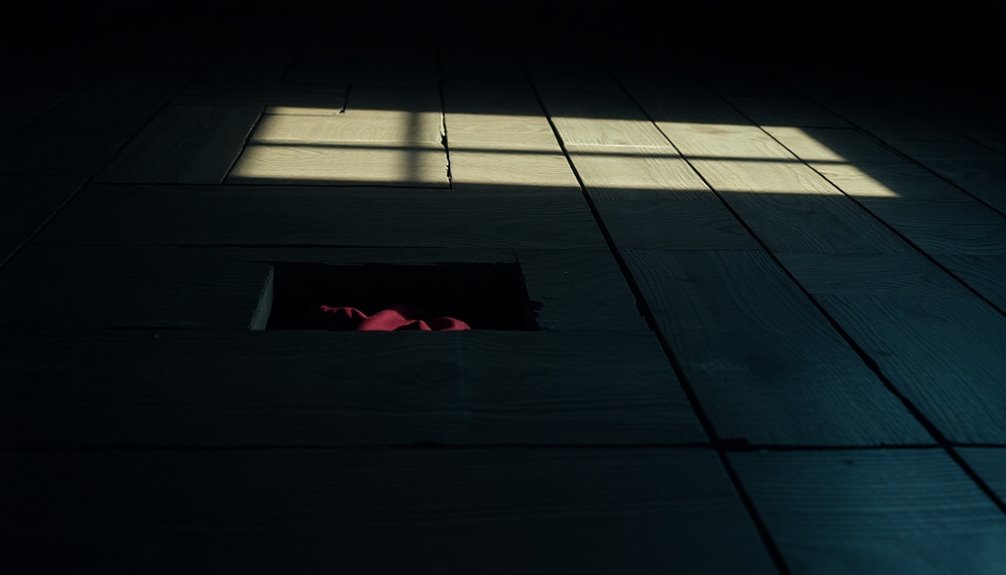
Beneath the surface of the narrator's carefully constructed facade, the floorboards in "The Tell-Tale Heart" serve as a compelling symbol of concealment. These floorboards hide the terrible secret—the body of the old man. You can see how they represent more than just wood; they illustrate the narrator's desperate need to cover up his crime.
Consider these points about the floorboards:
- They mask the horror beneath, reflecting the narrator's attempt to maintain a normal life.
- The act of replacing the floorboards shows how he tries to hide his guilt from everyone around him.
- They symbolize the madness lurking just below his calm exterior, reminding us that appearances can be deceiving.
As the narrator believes he's outsmarted everyone, he underestimates the power of the truth. The floorboards become a metaphor for the darkness he's trying to keep hidden. They highlight his delusions of control and the internal conflict he faces.
In this way, the floorboards aren't just a physical barrier; they represent the boundaries between the narrator's reality and the chaos of his actions.
Guilt and Its Representation

In "The Tell-Tale Heart," guilt plays a huge role in how the story unfolds.
You'll notice how the narrator's heart beats louder and louder, reminding him of his terrible act.
This shows us how guilt can haunt someone, making them feel restless and even pushing them to confess.
Manifestation of Repressed Guilt
Repressed guilt takes center stage in "The Tell-Tale Heart," manifesting through the narrator's frantic efforts to hide his crime. You can see how he tries to bury the old man's body beneath the floorboards, which symbolizes his struggle to escape his wrongdoing. Yet, guilt doesn't just disappear. Instead, it keeps poking at him, like a pesky little reminder.
- The loud beating heart echoes in his mind, a constant reminder of his actions.
- He believes he pulled off the perfect crime, but deep down, his conscience is alive and kicking.
- The police officers' presence symbolizes the authority of his guilt, showing that he can't hide from what he's done.
As the story unfolds, that relentless heartbeat grows louder, pushing him toward the truth he desperately tries to ignore.
It's fascinating how overwhelming guilt can lead to self-destruction. When he finally confesses, it's like a weight has lifted, even though he's faced the harsh reality of his actions.
Through this journey, the story beautifully captures how repressed guilt can manifest and ultimately demand to be acknowledged.
Guilt's Psychological Impact
Guilt's psychological impact in "The Tell-Tale Heart" is palpable, as the narrator's mind spirals into anxiety and paranoia following his heinous act. After killing the old man, he tries to hide his crime, but his guilt quickly becomes too heavy to bear. Instead of feeling relief, he hears the old man's heart beating louder and louder in his mind. This heartbeat symbolizes his inner turmoil and constant reminder of what he's done.
As he interacts with the police, he believes he can trick them and escape his guilt. However, the more he denies his actions, the more his guilt consumes him. It's like a storm brewing inside, growing stronger with each passing moment.
By the story's climax, he can't hold it in anymore. His confession isn't a clear choice; it's an overwhelming response to the intense pressure of his guilt.
This powerful feeling shows how guilt can affect our minds. It's not just a feeling; it's a force that can drive us to the edge. In this tale, we see how guilt can lead to a breakdown, revealing the strength of our conscience.
Conscience and Justice Interplay
The narrator's descent into madness highlights the complex relationship between conscience and justice. As you read, you can feel how guilt takes over the narrator's mind. The old man's heartbeat, echoing in the narrator's ears, serves as a reminder of his wrongdoing. It's like guilt has its own voice, refusing to be ignored.
- The police officers represent justice, but they can't see the chaos within the narrator's mind.
- Trying to conceal the body under the floorboards shows how futile it's to hide guilt.
- The climax reveals that truth always comes out; the unbearable guilt leads to a confession.
This interplay of conscience and justice is fascinating! The heartbeat is more than just a sound; it symbolizes moral decay. The narrator's reality distorts as guilt consumes him, showing how conscience can be a powerful force.
In the end, you realize that even the cleverest plans can't escape the weight of guilt. Justice may be an external force, but conscience is something that lives inside us all. It's a reminder that we must face our actions, no matter how deeply we try to bury them.
Impact of Literary Devices

Literary devices in "The Tell-Tale Heart" pack a powerful punch, deeply influencing how readers perceive the narrator's descent into madness. The first-person narrator pulls you right into his troubled mind. You can feel his fear and obsession with the old man's eye, which symbolizes his inner turmoil. This eye drives the plot and highlights the narrator's mental disturbance.
Irony plays a big role too. The narrator thinks he's cleverly hidden his crime, but his guilt is like a loud drumbeat, leading him straight to confession.
The vivid imagery, especially the heartbeat, makes your heart race alongside the story, creating tension and horror. You can almost hear it pounding, can't you?
Foreshadowing hints at the narrator's inevitable downfall. It builds suspense, making you wonder when his carefully constructed facade will collapse.
Every device works together to deliver a thrilling experience.
Frequently Asked Questions
What Does the Watch Symbolize in the Tell-Tale Heart?
In "The Tell-Tale Heart," the watch symbolizes the passing of time and the weight of guilt.
As it ticks, it reminds you of the narrator's growing anxiety and fear. The steady sound reflects his obsession with the old man's heartbeat, showing how trapped he feels by his actions.
This watch highlights the contrast between life and death, revealing how he can't escape the consequences of what he's done.
It's a powerful symbol of his unraveling mind!
What Does the Lantern Symbolize in Tell Tale Heart?
The lantern in "The Tell-Tale Heart" shines a light on the narrator's mind, revealing his struggle with madness.
It's like a flashlight in a dark room, helping him see things clearly, but it also hides his true feelings.
As he focuses on the old man's eye, the lantern shows the clash between what he believes and the reality of his guilt.
It symbolizes his fragile sanity, flickering between light and dark, just like his thoughts.
What Does the House Symbolize in the Tell-Tale Heart?
In "The Tell-Tale Heart," the house symbolizes the narrator's mind.
Just like a house can hide secrets, the narrator hides his dark thoughts and feelings inside. The eerie atmosphere of the house mirrors his chaotic emotions.
When he hides the old man's body beneath the floorboards, it's like trying to bury his guilt. This shows how the outside seems calm, while inside, there's a storm of madness brewing!
What Does the Beating Heart Symbolize in the Tell-Tale Heart?
In "The Tell-Tale Heart," the beating heart symbolizes the narrator's deep guilt. You can almost hear it thumping, reminding him of his terrible crime.
As his fear and paranoia grow, the heartbeat gets louder, showing how his mind is unraveling. This sound represents his struggle between wanting to be sane and losing control.
Ultimately, it reflects his fear of being caught, leading him to confess. Guilt, it seems, just won't let him go!
Conclusion
In the end, symbolism in "The Tell-Tale Heart" shows us so much about guilt and madness! The eye and the heartbeat remind us how our feelings can take control, like a mischievous little gremlin. The floorboards hide secrets, just like we often try to hide our mistakes. Isn't it funny how a story about a scary old man can teach us about our own hearts? So, let's keep an eye on our feelings, shall we?




